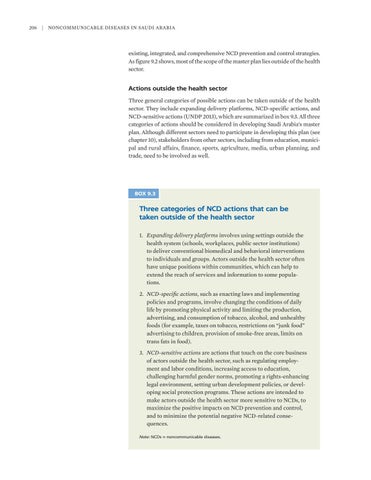206 | Noncommunicable Diseases in Saudi Arabia
existing, integrated, and comprehensive NCD prevention and control strategies. As figure 9.2 shows, most of the scope of the master plan lies outside of the health sector.
Actions outside the health sector Three general categories of possible actions can be taken outside of the health sector. They include expanding delivery platforms, NCD-specific actions, and NCD-sensitive actions (UNDP 2013), which are summarized in box 9.3. All three categories of actions should be considered in developing Saudi Arabia’s master plan. Although different sectors need to participate in developing this plan (see chapter 10), stakeholders from other sectors, including from education, municipal and rural affairs, finance, sports, agriculture, media, urban planning, and trade, need to be involved as well.
BOX 9.3
Three categories of NCD actions that can be taken outside of the health sector 1. Expanding delivery platforms involves using settings outside the health system (schools, workplaces, public sector institutions) to deliver conventional biomedical and behavioral interventions to individuals and groups. Actors outside the health sector often have unique positions within communities, which can help to extend the reach of services and information to some populations. 2. NCD-specific actions, such as enacting laws and implementing policies and programs, involve changing the conditions of daily life by promoting physical activity and limiting the production, advertising, and consumption of tobacco, alcohol, and unhealthy foods (for example, taxes on tobacco, restrictions on “junk food” advertising to children, provision of smoke-free areas, limits on trans fats in food). 3. NCD-sensitive actions are actions that touch on the core business of actors outside the health sector, such as regulating employment and labor conditions, increasing access to education, challenging harmful gender norms, promoting a rights-enhancing legal environment, setting urban development policies, or developing social protection programs. These actions are intended to make actors outside the health sector more sensitive to NCDs, to maximize the positive impacts on NCD prevention and control, and to minimize the potential negative NCD-related consequences. Note: NCDs = noncommunicable diseases.

